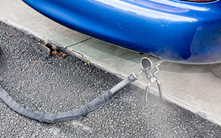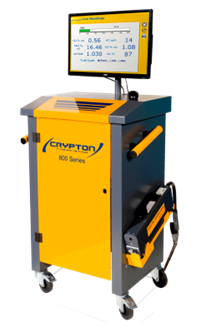An auto emissions test, or smog check/test, is an approach to quantify the pollutants released by a vehicle's exhaust system. Testing guarantees the vehicle abides by the criteria set by the environmental regulatory agency in a particular area or country.

Image Credit: Superior Sensor Technology
During an auto smog check, a vehicle is subjected to several tests and inspections to verify the grades of pollutants released. The necessities differ according to the jurisdiction and kind of vehicle. The procedure, nevertheless, commonly assesses the below-mentioned elements:
- Exhaust Gas Analysis: This test quantifies the levels of pollutants, such as hydrocarbons (HC), carbon monoxide (CO), nitrogen oxides (NOx), and, at times, particulate matter (PM), that exist in the exhaust gases of vehicles. The automobile links to an emissions testing machine, examining the exhaust gases’ composition.
- Onboard Diagnostic (OBD) System Check: Most modern vehicles have an OBD system that tracks the performance of several components associated with emissions control. The OBD system verifies it is working appropriately and that there are no sensed faults or malfunctions that could impact emissions.
- Visual Inspection: A visual inspection of the vehicle’s emission control system verifies the existence and condition of needed components, like the catalytic converter, PCV system, EGR valve, and other associated parts. Also, the inspection checks for possible modifications or tampering that might impact emissions.
- Evaporative Emissions Testing: Some areas conduct tests to check the reliability of the evaporative emissions control system of the vehicle. This system avoids the emission of fuel vapors into the atmosphere.
The smog test determines whether a vehicle fails or passes the emission standards. If the car passes, it complies with the regulations and can legally function on the roads. Alternatively, if the car fails, the owner must make the required repairs before the inspector can test it again.
Auto smog check frequency varies depending on factors such as the age of the vehicle, local regulations, and previous test results. These tests help to ensure that cars on the road are not contributing excessive levels of pollutants, thus promoting air quality and environmental sustainability.

Vehicle Emission Tester. Image Credit: Superior Sensor Technology
Role of Pressure Sensors in Emissions Testing
Pressure sensors are employed in emissions testing to enhance the precision and efficacy of the complete certification process. A few methods to use pressure sensors for smog checks are:
- Exhaust Gas Backpressure Measurement: In the exhaust system, pressure sensors can be installed to quantify the backpressure formed by the vehicle's gases. An increase in backpressure may signify a possible concern with the exhaust system, like a malfunctioning emission control component or clogged catalytic converter. By tracking the backpressure, the smog testing device can find vehicles that have the potential to fail the emission test and need further inspection.
- Vacuum System Monitoring: Pressure sensors can be used to track the vehicle's vacuum system. The vacuum system is critical in emissions control mechanisms, like the positive crankcase ventilation (PCV) system and the evaporative emission control system (EVAP). By quantifying the vacuum levels, the sensors can sense any irregularities or leakages in the vacuum system, which might increase emissions. This measurement aids in finding vehicles that require further examination.
- Fuel Pressure Measurement: Pressure sensors can also track the fuel pressure in the vehicle's fuel system. Proper fuel pressure is necessary for emission control and optimal combustion. Abnormalities from the anticipated fuel pressure range may signify concerns like a clogged fuel filter, faulty fuel pump, or fuel pressure regulator problems. Sensing such fuel system irregularities using pressure sensors can aid in identifying vehicles that need further evaluation during smog testing.
- EGR System Monitoring: The exhaust gas recirculation (EGR) system is critical for minimizing nitrogen oxide (NOx) emissions by recirculating certain exhaust gases into the combustion chamber. Pressure sensors can track the pressure levels of the EGR system and guarantee appropriate functioning. The sensor finds any abnormalities or deviations in the EGR system pressure, allowing for required adjustments or repairs to maintain optimal emissions control.
- Real-time Data Collection and Analysis: Combining pressure sensors with smog testing equipment enables the collection of real-time data on pressure levels during the testing process. This data is examined to find trends, patterns, or irregularities highlighting emission control issues. The capacity to collect and analyze pressure data in real-time improves the efficiency and accuracy of smog testing, allowing quicker identification of vehicles that need attention or fail to fulfill emission standards.
Altogether, incorporating pressure sensors in auto emissions testing contributes another layer of precision and monitoring, resulting in enhanced detection of emission-related issues and more effective identification of vehicles that need further repairs.

This information has been sourced, reviewed and adapted from materials provided by Superior Sensor Technology.
For more information on this source, please visit Superior Sensor Technology.